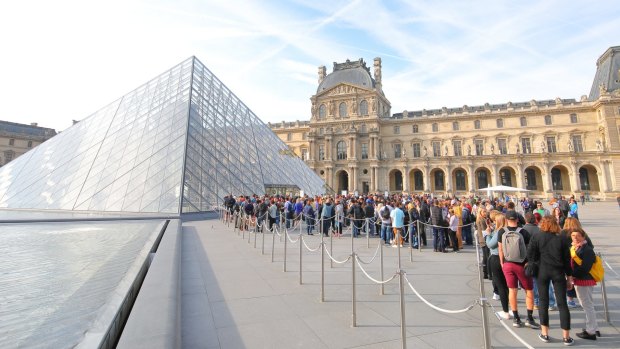This was published 1 year ago
How to avoid queues at the world's busiest tourist attractions

Visitors queue to enter the Louvre museum in Paris.Credit: iStock
As the tourism world moves back towards pre-COVID norms, queues at popular attractions are swelling, and advanced planning is once more a must to reduce wait times – or avoid not gaining entry at all.
For some places such as Amsterdam's Rijksmuseum or the Alhambra in Granada, you can no longer simply rock up: tickets with a specific time slot must be booked in advance. Even when not required, advanced online purchase puts you in shorter, faster queues.
An alternative is to pay more. Many attractions offer express options: pay an extra £13.50 ($24) at the London Eye, for example, and you'll avoid the sometimes two-hour wait. Check out the conditions of tourist passes: you won't have to join the ticket queues at the Tower of London if you have a London Pass, or at the Louvre with a Paris Pass.
Many sites have separate queues for anyone accompanied by a tour guide or in a tour group, making this a worthy option at the world's busiest places such as the Vatican Museums. An informative guide will also add depth to your visit. In Versailles, you can book guided tours that take you to closed areas and then set you free in public zones without having to queue.
Considering the tour-guide advantage, you might want to save your big-sight bucket list for coach tours or cruises, which benefit from fast-track entry. Steer your individual holiday time towards less frequented destinations or more esoteric museum choices.
If you insist on winging it, you can however still minimise queuing time. Shoulder seasons are quieter: Paris in October, Italy in May. In places that attract abundant domestic tourists, such as China and Japan, avoid school and national holidays as well as weekends. Research local quirks: Versailles is more crowded than ever on Tuesdays, for example, because many Paris museums are closed.
Time of day matters too. Tours groups and cruise excursions get off to slow starts, so be there at opening time. Evenings are often overlooked for sightseeing, but museums often have late-night openings (Thursday night at Musée d'Orsay, Friday at the British Museum) that are devoid of tour groups and children. The Empire State Building opens until midnight and is quiet after 10pm.
Many popular attractions and theme parks now have indicators on their websites of current queue times, or projected visitor numbers for certain days or even hours. Google also provides "popular times" details when you search attractions: scroll down to the blue chart and you'll discover entry to Musée d'Orsay is best at 9am on weekends, the Uffizi at 5pm on Fridays.
Finally, you may want to ask yourself whether you should bother at all. Do you really need to queue for hours to see the Mona Lisa? Paris is filled with dozens of fabulous but under-visited museums. In New York, the Frick Collection is a brilliant alternative to the ever-busy Metropolitan Museum, and in London the Wallace Collection offers a calm alternative to the National Gallery. Sometimes changing your mindset is the most rewarding strategy.
Sign up for the Traveller newsletter
The latest travel news, tips and inspiration delivered to your inbox. Sign up now.